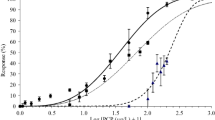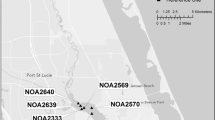Abstract
The occurrence of high concentrations of a PCB (Aroclor 1254) in the Pensacola estuary prompted field and laboratory studies by the Gulf Breeze Environmental Research Laboratory (EPA). Monitoring of the estuary indicates the chemical is present in all components-particularly in sediments and fishes. Residues appear to be diminishing in sediments. Toxicity tests show estuarine species sensitive at ppb concentrations in water, with a ciliate protozoan (Tetrahymena pyriformis W), shrimps (Penaeus duorarum, P. aztecus, andPalaemonetes pugio), and a fish (Fundulus similis), affected at or near 1.0 ppb. Tissue concentrations of Aroclor 1254 similar to those found in natural populations of shrimps from the contaminated estuary were successfully duplicated in laboratory experiments. Shrimps also concentrated the PCB from very low concentrations (0.04 ppb) in the water. Three estuarine species demonstrated pathologic changes at tissue and cellular level after chronic exposure to the chemical. Oysters (Crassostrea virginica) developed abnormal infiltration of leukocytes in the connective tissue, spot (Leiostomus xanthurus) developed fatty changes in their livers, and shrimp (Penaeus duorarum) developed crystalloids in hepatopancreatic nuclei.
Similar content being viewed by others
References
Butler, P. A.: Pesticides in the marine environment: J. Appl. Ecol.3 (suppl.), 253 (1966).
Cooley, N. R., J. M. Keltner, Jr., and J. Forester: Mirex and Aroclor® 1254: Effect on and accumulation byTetrahymena pyriformis W. J. Protozool.19, 636 (1972).
Couch, J. A.: Histopathologic effects of pesticides and related chemicals on the livers of fishes. Proc. Fish Disease Symposium. Armed Forces Inst. Path., Univ. of Wisconsin Press (In press) (1972).
Dahlgren, R. B., R. L. Linden, and C. W. Carlson: Polychlorinated biphenyls: Their effects on penned pheasants. Environ. Health Perspect.1, 89 (1972).
Duke, T. W., J. I. Lowe, and A. J. Wilson, Jr.: A polychlorinated biphenyl (Aroclor® 1254) in the water, sediment, and biota of Escambia Bay, Florida. Bull. Environ. Contam. Toxicol.5, 171 (1970).
Friend, M., and D. O. Trainer: Polychlorinated biphenyl: Interaction with duck hepatitis virus. Science17, 1314 (1970).
Hansen, D. J., P. R. Parrish, J. I. Lowe, A. J. Wilson, Jr., and P. D. Wilson: Chronic toxicity, uptake, and retention of Aroclor® 1254 in two estuarine fishes. Bull. Environ. Contam. Toxicol.6, 113 (1971).
Lowe, J. I., P. R. Parrish, J. M. Patrick, Jr., and J. Forester: Effects of the polychlorinated biphenyl Aroclor 1254 on the oysterCrassostrea virginica. Mar. Biol.11, 209 (1972).
Lowe, J. I., P. R. Parrish, A. J. Wilson, Jr., P. D. Wilton, and T. W. Duke: Effects of mirex on selected estuarine organisms. Trans. 36th N. Am. Wildl. Nat. Resour. Conf., p. 171 (1971).
Nimmo, D. R., and R. R. Blackman: Effects of DDT on cations in the hepatopancreas of penaeid shrimp. Trans. Am. Fish. Soc.101, 547 (1972).
Nimmo, D. R., R. R. Blackman, A. J. Wilson, Jr., and J. Forester: Toxicity and distribution of Aroclor® 1254 in the pink shrimpPenaeus duorarum. Mar. Biol.11, 191 (1971a).
Nimmo, D. R., P. D. Wilson, R. R. Blackman, and A. J. Wilson, Jr.: Polychlorinated biphenyl absorbed from sediments by fiddler crabs and pink shrimp. Nature231, 50 (1971b).
Norback, D. H., and J. R. Allen: Chlorinated aromatic hydrocarbon induced modifications of the hepatic endoplasmic reticulum: Concentric membrane arrays. Environ. Health Perspect.1, 137 (1972).
Södergren, A., Bj. Svensson, and S. Ulfstrand: DDT and PCB in South Swedish streams. Environ. Pollut.3, 25 (1972).
Vos, J. G.: Toxicology of PCBs for mammals and for birds. Environ. Health Perspect.1, 105 (1972).
Wildish, D. J.: The toxicity of polychlorinated biphenyls (PCB) in sea water toGammarus oceanicus. Bull. Environ. Contam. Toxicol.5, 202 (1970).
Author information
Authors and Affiliations
Additional information
® In this paper, Aroclor and PCB are used interchangeably for Aroclor 1254. Aroclor® is a registered trademark of the Monsanto Company, St. Louis, Mo. Reference to commercial products does not constitute endorsement by the Environmental Protection Agency.
Rights and permissions
About this article
Cite this article
Nimmo, D.R., Hansen, D.J., Couch, J.A. et al. Toxicity of Aroclor® 1254 and its physiological activity in several estuarine organisms. Arch. Environ. Contam. Toxicol. 3, 22–39 (1975). https://doi.org/10.1007/BF02221129
Received:
Accepted:
Issue Date:
DOI: https://doi.org/10.1007/BF02221129




